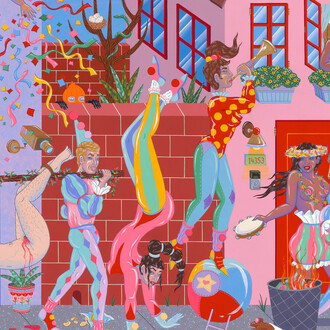Axel Wilhite contrasts environment and observation with a reliance on modern technology in his new series of paintings. Rendering meticulously small-scale paintings on top of discarded random-access memory (RAM) chips, Wilhite emphasizes the divide between the real and virtual in today’s technology driven society. The title of the show, Virtual Memory, references the material substrate of Wilhite’s painting: virtual memory or random-access memory chips (RAM). These auxiliary memory modules store data in computers and are distinct from hard-drives as they preserve memory only in the presence of an electrical current. By using the memory chips as a vehicle for the miniatures, Wilhite calls attention to the disparity between how the human brain recalls memories in contrast to the perfect recall of computers.
Calling attention to the easy accessibility of information and storage in the digital age – Wilhite features animals, plants, tornadoes, forest fires as a means to pull the viewer back into their own natural environments, while still existing in the realm of the digital plane.
As a child of the 80s, I remember a time without the internet, when digital technology was novel. I am interested now in our overwhelming technological dependencies — how they change us and our sense of our environment. I am interested in the extent to which “the virtual” has memorialized and replaced “the real,” as well as the impoverishment of the texture of lived reality in the age of Instagram, Wikipedia, and Google Search.
Susan Feldman constructs a spiritual journey of ladder-like frameworks through the layering of materials in her compositions. These structured sculptures act as three dimensional landscapes, evoking the stratified, fragmentary nature of history and memory.
Using found objects including distressed wood, colored string, and old photographs printed on plexi-glass, Feldman dignifies these discarded materials as environments of observation. Arranged as architectural plans, Feldman transforms each assemblage into a rising structure, that in turn references a metaphorical self-growth.
This current body of work was inspired by meditation practice and visualizes the spiritual enlightenment of “rising-up.” These all-over compositions take the eye through various planes and materials, which parallel the obstacles and stages of progress through that journey. As opposed to utilitarian constructions indicative of the urban skyline filled with high-rises, Feldman designs structures of contemplation, memory, and hope.
















